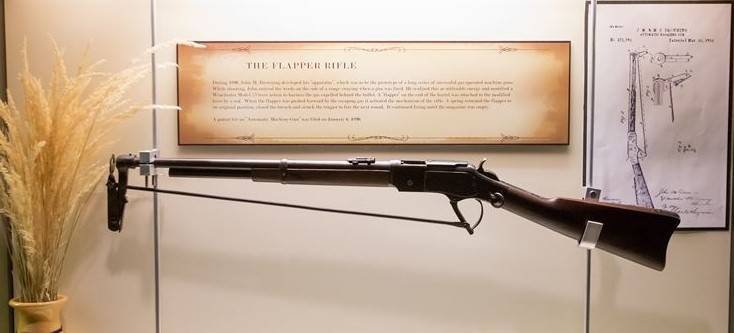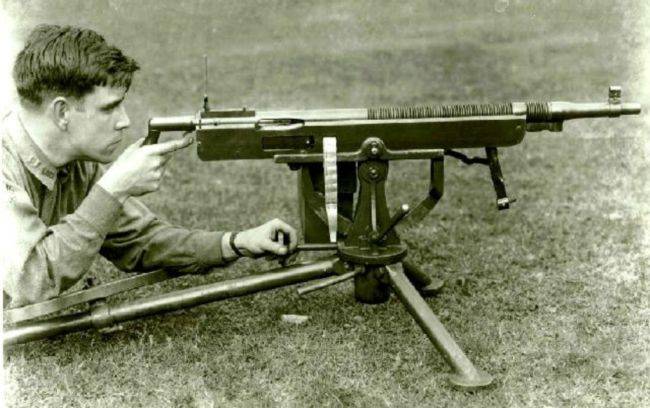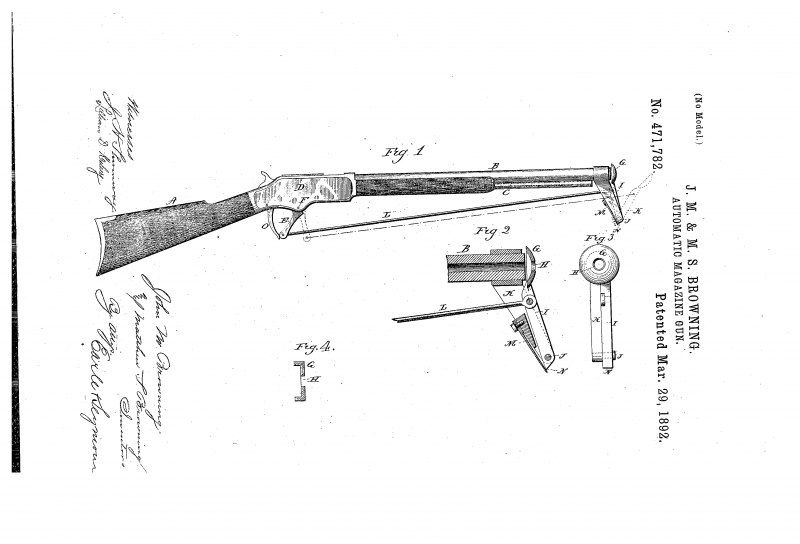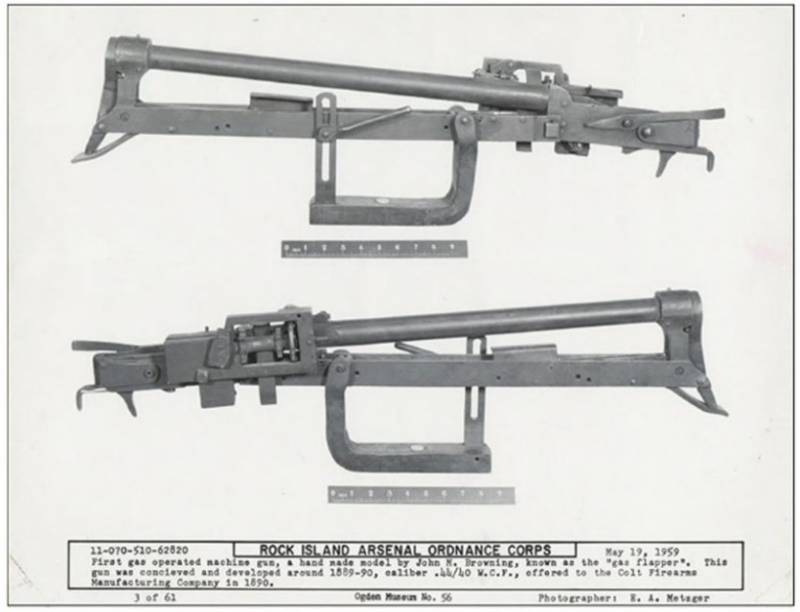Experimental rifle and machine gun Browning Flapper (USA)
In the late eighties of the XIX century, John Moses Browning, already famous for his developments in the field of small arms, was looking for the optimal architecture of self-loading or automatic systems. One of the sources of energy for self-reloading of weapons was already considered powder gases, accelerating the bullet. However, before it was required to determine how they can be “tamed” and use their energy in the recharge cycle. In addition, the proposed ideas of this kind needed to be tested in practice with the help of prototypes.

An experienced Browning Flapper rifle in the Browning Museum. Photo Browning.com
The emergence of a new self-loading weapon was preceded by a curious story. At the beginning of 1890, the J.M. Browning with his brother Matthew went to the shooting range. While competing in rifle shooting, they noticed that powder gases flowing from the barrel blow dust or move grass. Their energy could be directed in the right direction and used to reload weapons. On the same day, John invented a way to collect the energy of gases with simultaneous transfer to the mechanisms of weapons. Just a couple of days, the designer returned to the shooting range with an experimental rifle of a new type.
The original idea of using gases was implemented in the form of a demonstrator of technology as simple as possible. The basis of such a product was a finished rifle of the production model, and new solutions were embodied in a set of special details. This approach simplified preparation for testing, but still allowed to establish the real pros and cons of the new scheme. Having checked the modified rifle, it was possible to continue the development of existing ideas or to search for completely new solutions.
Looking ahead, it should be noted that a swinging plate was used to receive the energy of the powder gases on the test rifle. At a certain stage of reloading the weapon, she struck her footing, making a loud sound. For this reason, J.M. Browning called the experimental model "The Clapper" - "Flapper". Now to this name often add the name of the designer.
The product Browning Flapper was built on the basis of the finished serial rifle with manual reloading. It was a Winchester Model 1873 rifle with manual-action lever mechanics. Such a rifle was a long-barreled weapon for a unitary cartridge, equipped with a tubular magazine under the barrel. Recharging was carried out using a movable trigger guard. Due to the system of levers, she moved the bolt back and forth, simultaneously cocking the trigger and feeding the new cartridge to the filing line. Ergonomics and sights such a rifle were standard for its time.
New project J.M. Browning offered minimal rework on existing weapons. It was supposed to lose only two full-time parts, as well as get a few new devices. All these devices, as can be judged, the designer made by himself and installed on an experimental sample on his own. It should be noted that the installation of such devices was extremely simple and did not require reworking any parts of the rifle.
Like other rifles with a lever mechanism, the Winchester M1873 was equipped with a so-called. Henry brace in the form of a closed ring at the back and an open contour under the trigger. Moving the bracket back and forth, the shooter made preparations for a new shot. Picking up the "Flapper", Browning removed from the rifle full-time bracket. Instead, he installed a slightly curved lever on the same axis. His upper arm was connected to internal mechanics, while the lower one was connected to the gas engine. Also under the replacement went the trigger. The new part has a greater length. In the neutral position, its lower part was in contact with the movable lever.
The Flapper rifle received a special paddle device. A large collar appeared on the trunk section, from which a vertical support departed from below. On the plate support placed along the axis of the trunk, the main element of the gas engine was installed - a swinging plate. Its flat bottom part with the simplest hinge from the screw was fixed on the support. In the rear part of the support, it was planned to install a small leaf spring interacting with the swinging part.
The upper part of the hinged plate was on 90 ° rotated relative to the bottom and placed perpendicular to the axis of the trunk. It had a round shape, and in its center a hole with a diameter slightly larger than the caliber of the bullet was envisaged. The round element of the plate was supposed to perform the functions of a piston that receives energy from powder gases.
Swinging plate-piston got a tight connection with the recharge lever. They were joined by the simplest of metal. The latter was a metal rod of great length and provided the simultaneous displacement of two parts forward or backward for performing various operations during the recharge cycle.
Installing new parts in a certain way affected the ergonomics of the resulting automatic rifle. The longitudinal traction under the lodge and barrel could to some extent impede the handling of weapons. In addition, accidental contact with any foreign object could block the operation of automation or lead to an unexpected shot. However, the technology demonstrator did not require high technical and operational characteristics.
The principle of the Browning Flapper rifle was extremely simple. Preparing weapons for firing was the same as in the case of the base Winchester M1873, but was slightly different due to the different form of the reload lever. By loading the cartridges into the magazine and cocking the trigger, the shooter could point the weapon at the target and pull the extended trigger. The trigger triggered the ignition of the propellant charge in the sleeve, and the bullet began to move along the bore. In the case of the basic version of the M1873, the shooter would then have to work with the Henry brace, however, the Browning Clapper performed recharging on its own.
Coming out of the barrel, the bullet passed freely through the plate-piston and began to fly to the target. Powder gases going after it, in turn, hit the plate and transferred a substantial part of their energy to it. The impulse from the gases made the plate deflect forward, overcoming the resistance of the leaf spring and the mechanisms of the weapon. Moving forward, the swinging plate carried along the traction and the reload lever, which was responsible for throwing the cartridge out and at the same time cocking the hammer.
Having squandered the received energy, the lamellar piston returned to its initial position under the action of a spring, and also moved the thrust with the recharge lever. When this happened rassilanie new cartridge, and the rifle could make a new shot. Leaving back, the reload lever pressed on the elongated trigger, initiating a new shot. The cycle of automation was repeated.
Demonstrator technology under the frivolous name Flapper could make several shots in a row, up to the full use of ammunition. Thus, this weapon - with certain reservations - can be quite attributed to the modern class of automatic rifles. However, the lack of the ability to stop shooting at an arbitrary point in time after any shot makes it difficult to accurately classify the weapon, as well as hinder its full operation.
Just a few days after the friendly competition, during which the idea of the original design of automatic weapons appeared, the Browning brothers returned to the shooting range with an experimental model "Slaps". In practice, it was found that such a mechanic does provide automatic reloading of “manual” weapons after each shot. In addition, the product has fully confirmed its name: the shot of the shot was followed by the clang of metal parts.
For obvious reasons, the Browning Flapper rifle was not suitable for practical use. In this regard, J.M. Browning began to assemble a new product with a similar purpose. With the help of specially created experimental weapons, he planned to work out new ideas, as well as introduce a new system of ammunition, better suited to the presence of automation.
The new version of the "Slaps" was developed as a promising machine gun, although it was actually a prototype model. In the proposed form, it could only be used with a machine or test bench. Its main detail was the L-shaped frame, on which the receiver, barrel and trigger mechanism were fixed. Longitudinal traction, transferring the energy of gases to recharge mechanisms, was now placed inside the frame. The swinging plate-piston, as well as its return spring, were fastened in the vertical front part of the frame. The hinge plate was at the bottom, and under it set the leaf spring.
The second sample had a different ammunition system. In the first case, the regular tubular magazine of the M1873 rifle was used. The new model received funds for receiving canvas ribbons with cartridges. A full firing trigger was used with the ability to fully control the shooting and non-automatic fuse. The control of the weapon was carried out using the trigger and side flag.

The final result of all the work on the topic of "crackers" is the machine gun J.M. Browsing M1895. Photo Modernfirearms.net
To conduct test firing, the second Browning Flapper product was fixed on the stand with the help of a special machine. It was based on an L-shaped part with a hinged mount for the frame. On the side of such a support, a simple system was provided for controlling vertical guidance and fixing the weapon in a predetermined position. Horizontal guidance was obviously carried out by turning the whole system on the stand.
Tests of the new prototype took place in 1889-90 and confirmed that the weapon can actually use the energy of powder gases to recharge. In 1890, the J.M. Browning offered his new machine gun company Colt, but she was not interested in this project. Probably, gunsmiths did not suit the specific characteristics of the applied gas engine.
The scheme with a movable plate-piston, in principle, solved the tasks, but was not without flaws. This design of the gas engine had extremely low performance, and could also be damaged when transporting weapons or when fired. Thus, the device receiving the energy of gases, should be processed and transferred to another part of the weapon. In this form, an automatic rifle or machine gun could show high technical and operational characteristics, and in the future even go as far as mass production and get into army arsenals.
According to the results of tests of the experimental "Flappers" and the experienced machine gun J.M. Browning has developed a new version of the vapor control automation, more reminiscent of modern systems. Powder gases to the piston are now proposed using a vent hole in the lower part of the barrel. The piston itself was supposed to be under the barrel and move up and down when firing. Soon, such an automatic weapon architecture was implemented in the Browning Model 1895 machine gun. For the characteristic movable piston, the machine gun received the playful nickname Potato Digger - “Potato Digger”.
In contrast to the great variety of various experimental and prototypes of the most interesting small arms, the very first Browning Flapper product has survived to the present day. For many years, the location of the rifle remained unknown, but later it turned out that it was kept in the museum of the Rock Island Arsenal organization. Several years ago, this organization agreed with the Browning Firearms Museum (Ogden, Utah) on the transfer of a unique sample. In January, 2016, after repair and restoration, the product got into the permanent exhibition of the museum of J.M. Browning in his homeland. Now, a unique product that seriously affected the development of small arms can be seen by all museum visitors.
Experimental demonstrator rifle technology "Cracker" was created for the practical testing of specific ideas related to the automation of the process of reloading weapons. The rebuilt M1873 rifle showed the fundamental possibility of using such a design, after which new research and development work was carried out with the help of a specialized prototype. The latter actually became the predecessor of the first serial machine gun designed by J.M. Browning - the famous "Potato digger" M1895, and can also be considered the progenitor of the mass of other samples of small arms with automatic based on a gas engine. And the start of all these projects was given by scattering dust and swinging grass. So engineering ingenuity and observation have made the most serious contribution to the development of automatic weapons.
Based on:
http://browning.com/
http://standard.net/
https://strangernn.livejournal.com/
https://patents.google.com/patent/US471782


Information